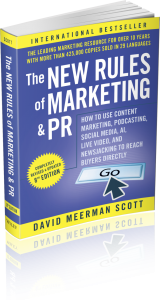 The ways we communicate continue to evolve. Keeping pace with the latest trends in social media and online video, while preventing your product or service from getting lost in the digital clutter, is a daunting task. David Meerman Scott is a master at helping you speak directly to your audience, make a strong personal connection, and generate attention for your business.
The ways we communicate continue to evolve. Keeping pace with the latest trends in social media and online video, while preventing your product or service from getting lost in the digital clutter, is a daunting task. David Meerman Scott is a master at helping you speak directly to your audience, make a strong personal connection, and generate attention for your business.
In the eighth edition of The New Rules of Marketing & PR: How to Use Content Marketing, Podcasting, Social Media, AI, Live Video and Newsjacking to Reach Buyers Directly, David explores the latest approaches for highly effective public relations, marketing, and customer communications – while helping you avoid of the costs of traditional advertising!
 I had the opportunity recently to interview David, a marketing strategist, entrepreneur, investor and advisor to emerging companies, and bestselling author of 12 books, including Fanocracy, about the new eighth edition of The New Rules of Marketing & PR.
I had the opportunity recently to interview David, a marketing strategist, entrepreneur, investor and advisor to emerging companies, and bestselling author of 12 books, including Fanocracy, about the new eighth edition of The New Rules of Marketing & PR.
Throughout his career he has been fascinated by seeing the future of how people and organizations work together, studied ‘what’s next’, and looked for patterns others don’t see.
Three times a year David (@dsmcott) is the lead marketing speaker at the legendary Tony Robbins Business Mastery events, delivering a two hour session on New Marketing Mastery.
Below is the text of the interview:
1. What is the biggest change in either PR or Marketing that today’s companies face?
I wrote this for the first edition of The New Rules of Marketing & PR back in 2007: “There used to be only three ways to get noticed: Buy expensive advertising, beg the mainstream media to tell your story for you, or hire a huge sales staff to bug people individually about your products. Now we have a better option: publishing interesting content on the web, content that your buyers want to consume.” The same is true today upon the publication of the 8th edition!
The tools of the marketing and PR trade have changed. The skills that worked offline to help you buy or beg or bug your way into opportunity are the skills of interruption and coercion. Online success comes from thinking like a journalist and publishing amazing content that will brand you as an organization or person it would be a pleasure to do business with. You are in charge of your own success.
2. Must companies re-think their approach to PR in the digital age?
Many people steeped in the tradition of product promotion naturally feel drawn to prattle on and on about their products and services. But I have news for you. Nobody cares about your products and services. Yes, you read that right.
What people do care about are themselves and how you can solve their problems. People also like to be entertained and to share in something remarkable. In order to have people talk about you and your ideas, you must resist the urge to hype your products and services. Instead, create something interesting that will be talked about online. When you get people talking on the Web, people will line up to learn more and to buy what you have to offer.
Sadly, marketers continue to hype products and services instead of understanding buyers and creating interesting content to reach them.
3. Do press releases still have value?
Yes, press releases have value but way less than most PR professionals believe. There is so much more that can be done.
Somehow along the way PR professionals have lost sight of what ‘true’ PR is and have set their focus on the media. What quick steps can PR pros take to get back to the public relations roots of creating mutually beneficial relationships with all of their publics (shareholders, stakeholders, communities, employees, etc.)?
To paraphrase the Public Relations Society of America (PRSA), definition: “Public relations helps an organization and its publics adapt mutually to each other.”
Nowhere does this description mention the media!
Somewhere along the line “public relations” became the same as “media relations.” What people need to realize is that these are different activities. Media relations, or working through journalists, is fine. Hey, who doesn’t want to be quoted in an important outlet?
But there are so many other ways to hear attention.
PR is about reaching your audience. There are many more ways to do that than just via the media: YouTube videos, blog posts, eBooks, charts, graphs, photos, a Twitter feed, a presence on Instagram, TikTok and so much more.
4. What role should LinkedIn play in companies’ marketing strategies? Any difference in your answer for B2B vs. B2C companies?
There are many social networks out there and LinkedIn is one of them. Marketers should understand their buyers and be active on the social networks that are most important to them. For many B2B businesses, LinkedIn is super important, so for them yes, LinkedIn is valuable. However many people use LinkedIn as another way to send unwanted sales messages. To be effective people should use LinkedIn to publish content and to engage with other people’s content.
Continue reading the rest of our conversation on CustomerThink
SIX more questions and answers!
![]() Sign up here to get Human-Centered Change & Innovation Weekly delivered to your inbox every week.
Sign up here to get Human-Centered Change & Innovation Weekly delivered to your inbox every week.
 Despite the fact that Twitter has been around since 2006 and Facebook has been around since 2004, social media is still the bright shiny object in the room (it’s still the current marketing fad). People still think they are being innovative if they use it, and unfortunately many people still approach it as something separate and scary instead of treating it as just one tool in the toolbox of anyone working in marketing or innovation. Yes, I linked social media to innovation in the last sentence and that’s because in the same way that social media is a tool that all marketers must learn how to use as part of an integrated marketing campaign, innovation managers must also learn how to use social media properly as part of their innovation efforts.
Despite the fact that Twitter has been around since 2006 and Facebook has been around since 2004, social media is still the bright shiny object in the room (it’s still the current marketing fad). People still think they are being innovative if they use it, and unfortunately many people still approach it as something separate and scary instead of treating it as just one tool in the toolbox of anyone working in marketing or innovation. Yes, I linked social media to innovation in the last sentence and that’s because in the same way that social media is a tool that all marketers must learn how to use as part of an integrated marketing campaign, innovation managers must also learn how to use social media properly as part of their innovation efforts.